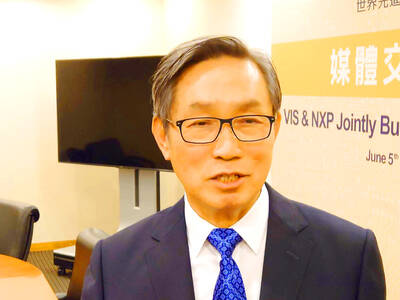CPC Corp, Taiwan (CPC, 台灣中油) yesterday reiterated its pledge to meet the public’s expectations after its proposal to build a third liquefied natural gas (LNG) terminal in Taoyuan narrowly passed an environmental impact assessment earlier in the day.
The state-run refiner said that it has cut the scale of the project from 232 hectares to 37 hectares to minimize its effects on the coastal algal and coral reefs near the site of the terminal in Taoyuan’s Kuantan Industrial Park (觀塘工業區).
The terminal’s industrial port would be off the coast, which would leave ocean currents undisturbed, CPC added.
A committee comprised of experts, members of conservation groups and environmental advocates would be formed, and given a budget to monitor the projects ecological effects, CPC chairman Tai Chein (戴謙) said, adding that he is willing to serve as a lifelong volunteer on the committee.
The project is strongly opposed by environmentalists who have called for the conservation of an endemic species of Crustose coralline algae on coastal reefs at the planned construction site.
However, CPC said the terminal is a crucial aspect of the nation’s transition toward renewable energy and a green economy.
The planned facility is expected to begin supplying fuel to Tatan Power Plant (大潭電廠) in January 2023 to meet the government’s goal of making cleaner gas power a bigger part of the nation’s energy source and cut reliance on more polluting coal-fired power plants.
Deputy Minister of Economic Affairs Tseng Wen-sheng (曾文生) said that the facility would help ease the nation’s strained LNG infrastructure, which is operating at about 103 percent capacity.
Once online, the facility would bring down LNG capacity utilization to 87 percent and cut the transport distance of fuel to meet the energy demand from northern industrial hubs, Tseng said.
Despite receiving the green light from the environmental impact assessment committee, CPC must continue its mission to advance Taiwan’s energy transition, which has been progressing amid tremendous mistrust and scrutiny, he added.

STEEP DECLINE: Yesterday’s drop was the third-steepest in its history, the steepest being Monday’s drop in the wake of the tariff announcement on Wednesday last week Taiwanese stocks continued their heavy sell-off yesterday, as concerns over US tariffs and unwinding of leveraged bets weighed on the market. The benchmark TAIEX plunged 1,068.19 points, or 5.79 percent, to 17,391.76, notching the biggest drop among Asian peers as it hit a 15-month low. The decline came even after the government on late Tuesday authorized the NT$500 billion (US$15.2 billion) National Stabilization Fund (國安基金) to step in to buoy the market amid investors’ worries over tariffs imposed by US President Donald Trump. Yesterday’s decline was the third-steepest in its history, trailing only the declines of 2,065.87 points on Monday and

TAKING STOCK: A Taiwanese cookware firm in Vietnam urged customers to assess inventory or place orders early so shipments can reach the US while tariffs are paused Taiwanese businesses in Vietnam are exploring alternatives after the White House imposed a 46 percent import duty on Vietnamese goods, following US President Donald Trump’s announcement of “reciprocal” tariffs on the US’ trading partners. Lo Shih-liang (羅世良), chairman of Brico Industry Co (裕茂工業), a Taiwanese company that manufactures cast iron cookware and stove components in Vietnam, said that more than 40 percent of his business was tied to the US market, describing the constant US policy shifts as an emotional roller coaster. “I work during the day and stay up all night watching the news. I’ve been following US news until 3am

Six years ago, LVMH’s billionaire CEO Bernard Arnault and US President Donald Trump cut the blue ribbon on a factory in rural Texas that would make designer handbags for Louis Vuitton, one of the world’s best-known luxury brands. However, since the high-profile opening, the factory has faced a host of problems limiting production, 11 former Louis Vuitton employees said. The site has consistently ranked among the worst-performing for Louis Vuitton globally, “significantly” underperforming other facilities, said three former Louis Vuitton workers and a senior industry source, who cited internal rankings shared with staff. The plant’s problems — which have not

TARIFF CONCERNS: The chipmaker cited global uncertainty from US tariffs and a weakening economic outlook, but said its Singapore expansion remains on track Vanguard International Semiconductor Corp (世界先進), a foundry service provider specializing in producing power management and display driver chips, yesterday withdrew its full-year revenue projection of moderate growth for this year, as escalating US tariff tensions raised uncertainty and concern about a potential economic recession. The Hsinchu-based chipmaker in February said revenues this year would grow mildly from last year based on improving supply chain inventory levels and market demand. At the time, it also anticipated gradual quarter revenue growth. However, the US’ sweeping tariff policy has upended the industry’s supply chains and weakened economic prospects for the world economy, it said. “Now